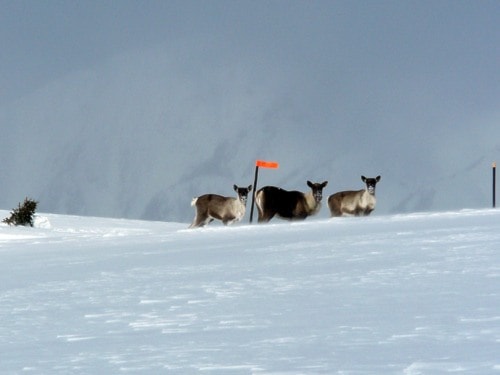“Did you get any photographs?”
That was the first question Mike Wiegele Helicopter Skiing operations manager and lead guide Bob Sager asked when one of his guides reported seeing a group of eight to 10 snowmobilers roar past a sign that said an area was closed to snowmobiling.
The incident occurred near Miledge Creek northwest of Blue River on Friday, Mar. 9.
It happened so fast that the guide had been unable to get a photograph. However, he did report it to the heli-ski company’s radio operator for possible follow-up with a conservation officer.
The violation incident was just one item reported during an in-depth debriefing held daily with the guides, helicopter pilots and others involved with the heli-ski operations.
About 20 people took part in the Mar. 9 meeting at the Guides Haus in Mike Wiegele Heli-ski Village in Blue River. Another four or five took part by videoconference from Wiegele’s Albreda Lodge.
Most of the information exchanged involved avalanche dangers and other hazards, as well as ski conditions
There was one other mention of wildlife, however. One guide reported seeing only tracks near the Tiffany Run, which is located between Lempriere and Chappel creeks. He felt the animals had moved on and that the run, which had been closed because of an earlier sighting, could now be re-opened.
The item about caribou tracks was just one more piece of information that would be added to the database the heli-ski company is compiling about wildlife in the upper North Thompson Valley, said Jordan Stiefvater, the guide with responsibility for wildlife monitoring.
The database includes information dating back more than 20 years that has recently been entered by hand.
“There is a ton of information with all our runs mapped out on Google Earth,” Stiefvater said.
All sightings of mountain caribou, mountain goats, plus predators such as wolverines, wolves and cougars are entered in the database.
Where possible, wildlife is photographed, although many of the pictures are not clear because the heli-ski company endeavors to keep a 500 m distance.
Rick Kunelius, the former chief wildlife warden at Banff National Park, acts as a consultant on the program.
The heli-ski guides have strict protocols to follow whenever they encounter wildlife, said Stiefvater.
All sightings must be reported immediately to radio dispatch for logging in on the daily activity report.
When caribou or goats are seen near a ski run but not on it, an alert is posted. Basically, this means the run needs to be checked before it can be skied.
If caribou or goats are seen on or in the immediate vicinity of a ski run, that run is closed right away. Closures normally last for 48 hours, after which it becomes an alert - meaning the run must be checked before it is skied.
The mountain of data proves that the heli-ski operations do not interfere with the mountain caribou, said Mike Wiegele.
“We’ve been doing this for over 40 years,” said Wiegele. “We have a very good relationship with the caribou.”
The heli-ski operator pointed out that the majority of his clientele are environmentally aware and would not tolerate any procedures that might be harmful to wildlife.
Some are even on the boards of well-known international environmental organizations.
“They scrutinize us up and down and if I make the wrong move, they’re not coming back,” he said.
Snowmobiling is a far more serious threat to caribou, he felt.
More people are snowmobiling, their machines are more capable of getting into the high country, and resource roads have increased access.
“This is getting worse, by leaps and bounds, not better,” Wiegele said.
One area they heli-skiers used to call Caribou Hideout is now called Caribou Chase.
On more than one occasion, caribou have moved in among a group of skiers, apparently seeking to escape from nearby snowmobilers, he said.
“We want to know what the environment ministry thinks,” Wiegele said. “Do they truly mean protection or are those just words?”
More about mountain caribou, including questions about heli-ski tenures, in next week's issue.
